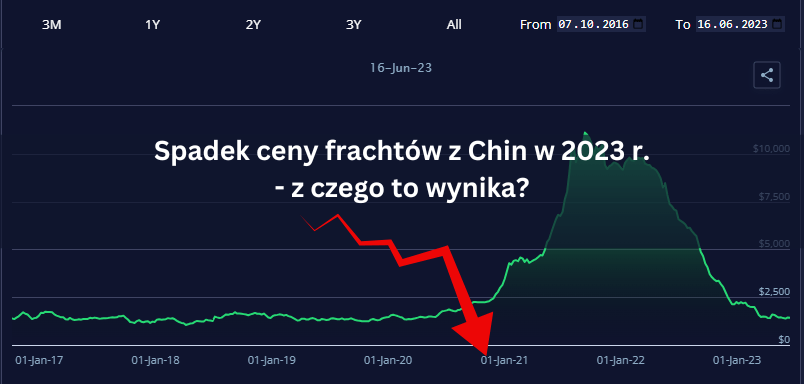Why did freight prices rise during the pandemic ?
Pandemic in the world of maritime transport, rail i aviation It turned everything upside down. Rates have skyrocketed from around USD 1 000 to around USD 10 000, and there have been times when rates have been as high as USD 15 000, and we are of course talking about shipping. This was due to factors such as the backlog of containers in lockdown countries, containers that arrive in Europe having to be transported empty back to the place of shipment, so that, in short, there is something to send the goods in. Another reason is the large COVID-19 restrictions in China, where major restrictions have been introduced. There have also been situations where the largest ports in China, which handled a large proportion of cargo, have been temporarily closed, which has also resulted in higher rates.


-
10% discounts for the first transport
-
On offer: Rail, air and sea transport
Why have rates fallen so dramatically in 2023?
Looking at the graph above, the question arises as to why there has been such a drastic drop. The last few months have seen a massive drop and currently the average index per 40 HC container of China by sea is around USD 1 250. It can be said that rates have returned to pre-pandemic levels. The chart below shows the index of rates from China to Europe. The graph shows the price averaged.
The first reason we will mention will be the decline in consumption in the European Union and post-pandemic uncertainty. A large proportion of households, due to the rising cost of living through inflation, have decided to cut spending on products that are not essential for living.
Another issue is the expansion of the fleet of cargo ships, the big investment in this area is due to the huge profits that shipowners made during the pandemic. Now they can actually go shopping and make investments in expanding their fleets. This creates more space on the market for ships by increasing the supply of sea freight so the price goes down.
Another thing is the global action of central banks raising interest rates to fight galloping inflation. This is intended to reduce demand and drive down prices in supply chains, which were at record levels during the pandemic and which also contributed significantly to inflation. Such measures could lead to a recession in the market and a weaker economy which will result in current rates being maintained in 2023 and 2024.
We can also find information in the media regarding statements made by the CEOs of some of the larger logistics companies, who confirm a decline in orders and volumes.
It is predicted that further restrictions on the number of seats on ships will not return and tough price competition between shipowners for market share will begin. We can already see this happening. Shipowners are currently maintaining similar rates, somewhat akin to price collusion. However, there is a chance that there will be a break-out, a price war will start and rates will go down a bit more. It is worth noting that shipowners have made quite a number of orders for new ships that will be commissioned over time, which will result in even more available capacity, a fight for market share and therefore a drop in prices.
However, it is impossible to clearly predict the situation and for the moment we must leave everything to the world of speculation.
Container tracking service Container XChange has noted that more 40-foot containers have entered the port of Shanghai each week since the beginning of the year than have left it. This was also the situation in Ningbo and Tianjin. The report was published for the month of February 2023.
In the graph below, we can see the decline in Chinese exports over 3 years.

In summary, freight prices from China should remain low through 2023 and 2024. In Q3 2023, when companies commoditise for the holidays, rates may rise, but the increase may be around 10-25 %. Time will tell what the next few years will look like, but we invite you to read the following articles.







